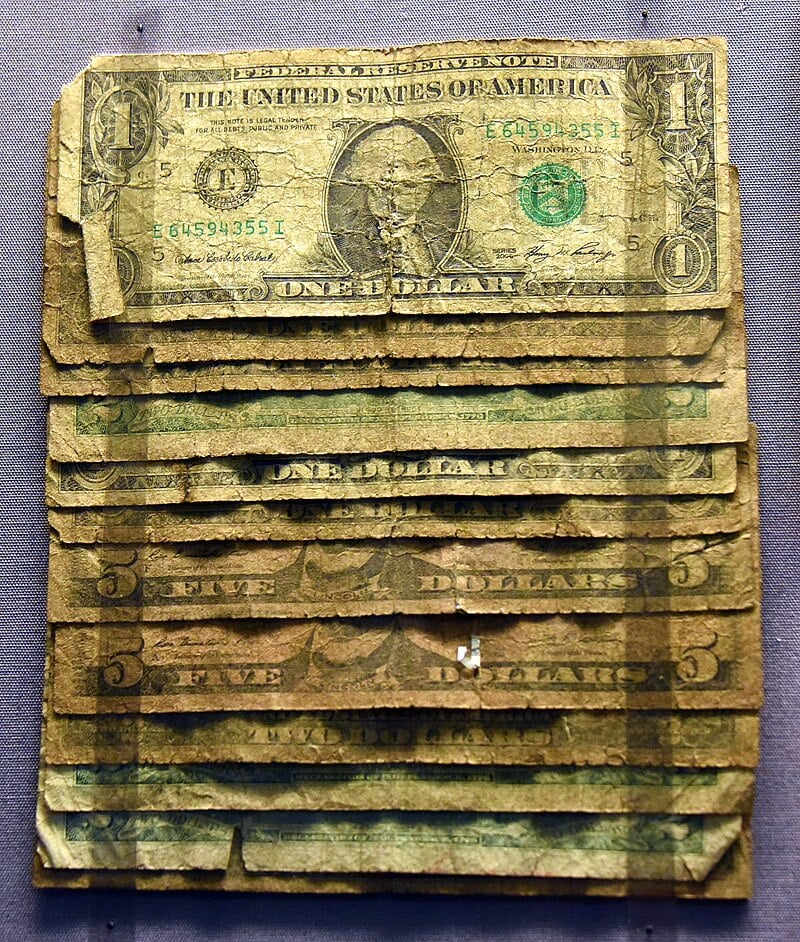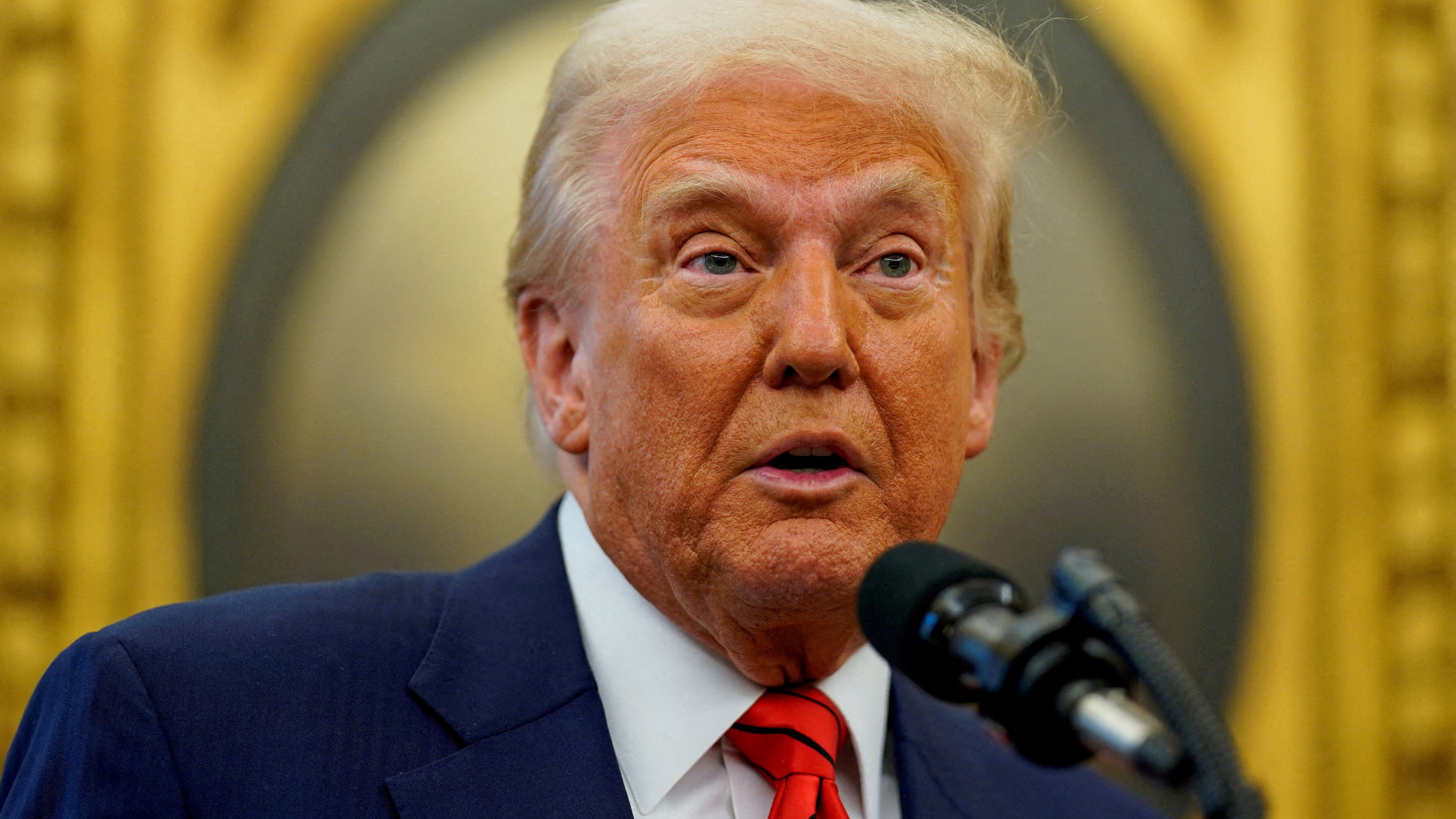Not gonna lie, I agree with this. Pennies are useless.
You know what they say, “even a broken penny is right twice a dollar”
Or something like that
Thanks to Trump, America doesn’t make any cents.
Slow clap…
The reason we continued to make the penny is to maintain zinc production, which is important for wartime manufacturing.
By ending penny production, it will save money, but may compromise our future ability to wage war.
If we want to have artificially-generated demand for zinc – if we really need to ensure domestic production capacity – there’s no requirement for it to be the penny. I’m sure that we can find something else to make out of zinc.
The penny itself wasn’t always zinc. I don’t remember the changeover year.
checks WP
https://en.wikipedia.org/wiki/Penny_(United_States_coin)
The current copper-plated zinc cent issued since 1982 weighs 2.5 grams, while the previous 95% copper cent still found in circulation weighed 3.11 g (see further below).
https://en.wikipedia.org/wiki/Zinc
Zinc is most commonly used as an anti-corrosion agent,[123] and galvanization (coating of iron or steel) is the most familiar form. In 2009 in the United States, 55% or 893,000 tons of the zinc metal was used for galvanization.[122]
Zinc is more reactive than iron or steel and thus will attract almost all local oxidation until it completely corrodes away.
We can just subsidize zinc production, or purchase something that requires those anti-corrosion properties.
I also am not at all sure that this was in fact the rationale. I can’t find a reference online to this being the rationale. I do see reference to zinc being useful because it’s particularly inexpensive. And the numbers given on this article seem to support the idea that pennies don’t really work out to generating a very substantial demand for zinc.
It’s Not Big Zinc Behind The Campaign To Keep The Penny
To run through the numbers, a penny coin weighs 2.5 grammes. Let’s call that all zinc (it’s not, but close enough). There’s 5 billion made a year, meaning that we’ve got 12,500,000,000 grammes, or divide by a million to get 12,500 tonnes. Now, if that were 12,500 tonnes of gold being made into coins every year, with global virgin production being around 3,000 tonnes, then sure, that would be a contract worth, umm, influencing the political process, to secure and keep running. The same would be true of many metals in fact. But it’s just not true of the zinc industry. Using the USGS, the correct source for these sorts of numbers, we find that US production of zinc is around 250,000 tonnes a year, global production 13.5 million. Even if we assume (as we might, sounds like the sort of thing that might be true) that US coins must be made of US produced metal this is still a very marginal part of the total market.
Further, zinc runs about $2,200 a tonne at present, meaning that we’re talking about maybe $25 million a year as the zinc cost of our pennies. And we’re told who and how much is paid to keep lobbying for the penny:
But his written statement did not mention that Weller is actually a lobbyist and head of strategic communications for Dentons, a law firm representing the interests of zinc producer Jarden Zinc Products, a major provider of coin blanks that are made into currency.
…
Jarden Zinc Products spent $1.5 million from 2006 through the first quarter of 2014 lobbying on such things as “issues related to the one-cent coin” and represented by Weller when he worked at B&D Consulting and, more recently, Dentons.No, the important point here is not the zinc industry, nor “Big Zinc”. The important part is this “a major provider of coin blanks”. If your business is making coin blanks then obviously you’re very interested in the continued existence of coin demoninations that are made from coin blanks. That they’re made from zinc is an irrelevance compared to that.
Believe me, you don’t spend the best part of $200,000 a year in lobbying expenses in order to sell $25 million’s worth of zinc. This metal is a commodity, you can sell that amount in one ten minute phone call to any London Metals Exchange ring member. Heck, give me a couple of days to get organised and I could sell it for you at the market price. I’d also charge rather less than $200,000 to do it.
EDIT: WP seems to also support the author’s argument.
https://en.wikipedia.org/wiki/Jarden_Zinc_Products
The company has resisted past efforts to eliminate the penny in the United [1] through an astroturf lobby organization called Americans for Common Cents.
The company’s largest source of revenue comes from the production of coin blanks, having produced over 300 billion blanks at their Tennessee facility.
tonnes
grammes
Did an Old English speaker write this?
I’m fairly sure that I’ve read some articles by this guy on Forbes before, because I remember that he had some article on something, many years back, that I really liked and I distinctly remember thinking that his thumbnail looked kind of frumpy. I believe that he’s British. Looks like he hasn’t been at Forbes in almost a decade, though.
kagis
Yeah, was apparently born in Torquay, England.
https://www.timworstall.com/2008/07/about-tim-worstall/
I was born in Torquay in 1963, grew up mostly in Bath (with a couple of years in Naples, Italy as a result of my father\’s Naval career) and was educated at Downside Abbey.
EDIT: Also, a “ton” and a “tonne” aren’t the same thing – that’s not just dialect. A “ton” here in the US means a short ton, 2000 US lbs. A “tonne” is a metric ton, 1000 kg. I don’t know what Brits normally mean if they write “ton”, whether it’s a short ton or a long ton or metric ton. In the US, we’d normally write “metric ton” instead of “tonne”.
Kagi is a for-profit website that charges people money to use their search engine.
Stop advertising for them.
Advertising does not belong on Lemmy and I will point this out every time I see you do it.
Calling that an advertisement for Kagi seems a bit hyper reactive to me. I think they’re just including it as a source along with the info for transparency’s sake. I appreciate it for the context it provides.
If they didn’t explicitly do it every single times, and often italicize it, I might agree.
And then they wrote some ad copy for why Kagi is better than DuckDuckGo to me afterward because they decided (for some reason) that this was about which search engine was better, as if I gave a shit. Which, again, advertising.
Well yeah, italicizing it denotes that it’s the title of the source.
The “ad copy” was just them explaining why they personally like using Kagi, after you called them out for it.
With all that said, I think you’ll just end up Streisand effecting it in the end if you call it out over and over. 🤷♂️
You’re free to comment every time if you want. I have no intention to change what I am doing, because I happen to like them, and my use of the term predates my use of that engine – I wrote googles prior to this.
If you want to ban me because you cannot tolerate my writing style, do so, and I’ll go use communities other than those you that you moderate. Trying to harass me into changing what I write is not going to have an effect.
Yes, I understand you think, “hail corporate!” is a good thing, as is giving a corporation that would happily fuck you over in a second like every other corporation free advertising, and “I gave a different for-profit corporation free advertising before now” is a weird excuse to continue to do it.
Too bad there aren’t any non-profit search engines you could promote instead of the one that charges people money in order to make a profit.
But yes, I will point it out your “hail corporate!” shit every time because advertising does not belong on Lemmy.
Too bad there aren’t any non-profit search engines you could promote instead of the one that charges people money in order to make a profit.
If I remember from prior discussions, you prefer Duck Duck Go. If you want to mention that you use Duck Duck Go, I have no problem with that. I think that that’s great.
giving a corporation that would happily fuck you over in a second like every other corporation
I think that Kagi has considerably less-incentive to do so than Duck Duck Go does, because they have a viable revenue model that doesn’t involve datamining me the way Google does or showing ads to me the way Duck Duck Go does. Yes, you can use an ad-blocker on Duck Duck Go, but then you’re offloading the costs onto other users who don’t do that, and in the long run, Duck Duck Go has an incentive to block users using ad blockers.
You may disagree with my assessment. But I’ve made that decision, I’m happy with it, I like the fact that Kagi added a Threadiverse search feature, and I am not going to change search engines to your favorite search engine, nor do I intend to stop telling people that I use Kagi.
So two wins
Do you have a source for this?
https://www.usmint.gov/learn/history/historic-coin-production
For the year 1943, pennies became zinc-coated steel because copper was essential to the war effort during World War II.
This is the closest I could find and I really doubt that this means much in the 21st century.
I mean for fucks sake we were using depleted uranium rounds during the Iraq War, not copper.
You are correct on the Penny. The military still uses a lot of copper and zinc, just not how you are thinking. The “depleted uranium” rounds you are thinking of are anti-armor rounds. This is a fin stabilized sabot round that has a core penetrator made of DU instead of Tungsten, like the Russians use (we use some tungsten core rounds also). The US used these for the Bradley’s main 25mm Bushmaster auto cannon, M1 Abrams tank, 30mm fighter jet cannons and the big boy A-10 Brrrrt gun. Almost all small rounds, think infantry, use full metal jacket rounds. The core of the round (back then, now mostly steel) is made of lead. Then the lead is encased ( or jacketed) with copper. This would apply to 9mm pistol rounds(not used much in combat, if so, it is a bad day), M-16 5.56 rounds, .30 caliber machine gun, and .50 caliber machine and anti material rifles. Copper is used a lot in other areas also, primarily motor windings and generator windings. Zinc is used is almost everywhere as a galvanized coating on ammunition that is not jacketed and other things that have bare steel. The Bradley fires a standard round that is used more often than the DU sabot, called HEAT. This is an explosive round covered in steel with a jacket of zinc for corrosion resistance.
Excellent breakdown, thank you.
No problem. I have seen a lot of people think that the army was just tossing huge chunks of uranium around. The actual core made of depleted uranium is quite small, I believe it is less than 300grams in an Abrams 120mm shell. The cores are encased and not very radioactive, but I would bet they are still an environmental hazzard long after they are used. The US started using it when it proved harder of a penetrator than tungsten, and since it is a waste product, it was far cheaper.
What about galvanized steel though? You know, like traffic signs, light posts, some cars, various construction materials etc? You could use zinc in so many ways. I expect those applications would also take a lot more zinc than the pennies ever could.
So as soon as the zinc lobbyist pay him, he’ll back out.
What portion of our zinc production goes to manufacturing pennies?
someone tell him he’s just copying canada now
Maybe he should think of joining Canada instead of trying to take us over.
Nothing wrong with taking a good idea and following it yourself.
But from the person who likes to think he’s always leading and not just a little bitch, anybody pointing it out probably gets ousted.
Pennies should go away, but this isn’t the way to do it. Canada’s process was well thought out with lots of guidance and direction.
This is dumb and will cause lots of confusion.
Yes instead of no longer making them, there is a better way
Should also drop nickels, quarters, and one dollar bills.
We’ll have dimes (should be made larger), half dollar, and one dollar coins.
All prices can then be rounded to $0.1 instead of $0.01.When we got rid of hay pennies (worth half a penny) in 1857, they were worth more than $0.15 is today.
Only reason I’d keep the dime around, is because we aren’t quite ready to round prices to a whole dollar.The quarter is the biggest problem with this plan. There’s just too much stuff that runs on quarters and quarters themselves as a currency denomination have too much cultural staying power.
Unfortunately, there being a 25¢ coin rather than the more globally-common 0.20 piece means that it isn’t practical to retire the nickel because it will still be possible to get non-multiples of 10¢.
$1 notes are important, not because of any reason in the US (dollar coins would work equally well in almost any application), but because the US dollar circulates widely in foreign countries that are suffering hyperinflation of their local currencies and have thus informally dollarised. There, US coinage is basically non-existent meaning the lowest denomination that can be transacted in USD cash is $1. See the situation in Zimbabwe where American banknotes circulate until they literally fall apart or the ink has all faded away off.

So the existence of a $1 note is paramount to keeping the economies of these countries going. It would be impossible to conduct business if the smallest denomination is $5 and your $4 an hour salary is paid in cash.
Remember, as unfortunate as it is, much of the US’s monetary policy is driven by the fact that the US dollar isn’t just America’s currency. It’s the entire world’s currency.
Every pay phone in America cost a dime when I was little. Then, by the time I was old enough to need to carry around change for a pay phone, all of them only took quarters. Do you know how many millions of pay phones there used to be? They somehow found it cost-efficient to modify almost every single one of them in the entire country. After the Bell system was broken up.
During the era of payphones, a quarter was still significant money so it was still worth the time to adjust the machinery. Nowadays, there are typically only four machines that people regularly interact with that accept quarters:
- Laundry machines, which increasingly don’t take coins at all and instead have card readers on them
- Parking meters, which also increasingly get replaced with signs telling you to pay online using a website or app
- Vending machines, which also usually have card readers.
- Self-checkout machines at grocery stores.
These machines take coins, but generally deal in such small-dollar amount terms that replacing the coinage mechanisms just isn’t worth it in 2025. That’s the biggest issue with coinage reform plans. Hell, not even when the UK decimalised their currency did they change the size and weight of the coins, for exactly this reason. An old shilling was the same size, weight, and value as a new 5p coin and no changes had to be made to the machines.
Now, the problem is that while coin usage (and cash usage in general) is on the decline, these systems must still function for the percentage of people who want to use cash. And you definitely have a moral right to use cash and be able to conduct your daily life in cash if you want, either for privacy reasons, or because for small transactions it’s just simpler.
There’s just too much stuff that runs on quarters […] too much cultural staying power.
“Because that’s the way it is” is never a good reason not to do something new.
It’s always the case that things don’t change. Until they suddenly and unexpectedly do. Then in hind sight it seems obvious they should have changed long earlier.US dollar circulates widely in foreign countries […] There, US coinage is basically non-existent
There’s no real reason coins couldn’t circulate in foreign markets. They don’t because the value to weight ratio is worse for shipping. But if the coin value went up to a dollar, and the dollar note wasn’t an option anymore, foreign markets would adapt just fine. Especially since the coins would circulate for decades longer.
“Because that’s the way it is” is very often a good reason not to do something new. That’s because of the human aspect of introducing these reforms. There’d better be a very good reason to change or you will encounter a lot of public opposition just because people don’t like change.
There is no reason that coins
don’tcan’t circulate in foreign markets but the fact remains that they don’t (Edit: for lack of infrastructure to support the logistical challenges of distributing coins). You cannot explain that away. It is simply not possible to adapt in the situations I describe. Saying that “they’ll adapt” is a very hand-wavey excuse that doesn’t address the issues with retiring this denomination. Without a $1 note, people in the countries that need it will just not use the US dollar and will choose a currency that has the denominations they need. In Zimbabwe’s case, people would be forced off the US dollar and onto a currency that is willing to provide them with the small change that they need. In that case, probably the South African rand.Everything is the way it is. Yet things still change. Literally everything changes eventually. So no, it’s not a good reason, merely an empty excuse. “The human aspect”, is a less insulting sounding way of saying “People don’t like change.” Which is true, but as I already said, every thing changes anyway and people deal with it and adapt every time.
There is no reason that coins don’t circulate in foreign markets but the fact remains that they don’t.
That sentence is literal nonsense. As in, it doesn’t make sense.
If there’s no reason coins don’t circulate, then they would be circulating; Or could be made to circulate, with no real resistance or effort.Then you go on to further not explain why the dollar note is necessary in some markets, and they wouldn’t be able to adapt.
That’s a very hand-wavey way to create a roadblock excuse.These things don’t need to make sense. They very much don’t make sense. They are still real phenomena that need to be dealt with. You’re expressing a sentiment that I find is very common on Lemmy—that if it doesn’t make sense then it can be ignored.
If public sentiment is against a change that is perceived to be arbitrary and without benefit then you will encounter very real public opposition. There will be political repercussions to making this change. You will be slandered by pundits in the news and you personally will gain a reputation as a hard-ass who makes things hard for no reason (regardless of whether that’s true or justified), which causes problems for your future job security as now politicians think they can score easy political points by firing you. It wouldn’t be a consideration on Planet Vulkan, but on Earth, this effect is real and must be considered, whether you think it’s logical or not.
Coins don’t circulate in foreign exchange markets. They haven’t circulated for over a century. There are, however, reasons for this. You’ve already correctly pointed out that one of them is because coins are heavier. The second reason is because ATMs don’t dispense coins but they do dispense notes. When people go to the bank and withdraw money, they don’t receive coins unless specially requested. And despite the need for small change in these foreign countries, the logistical challenges of providing coins to them over notes are still too high for coins to find their way into circulation. Coins enter circulation in the US when businesses order them from the bank, which in turn orders them from the Federal Reserve, which receives them from the Mint. Banks abroad don’t bother with coins because they’re far more difficult to transport and distribute than notes, making it an unprofitable service to offer account holders, and they can’t just order them from the Federal Reserve—they need to go through a third party which increases costs. In addition to that, USD banknote-counting machines are prevalent worldwide. It’s rare to encounter a USD coin-counting machine abroad. The logistical network to distribute USD cash globally is built for notes, not coins, and that’s why trying to introduce coins in a foreign market is like trying to jam a square peg into a round hole. You’re going to find that every single step is going to be ever so slightly more frustrating than distributing notes, which all adds up to the point of impracticality.
You just eloquently explained some reasons. Why did you say there’s no reason coins aren’t circulated in foreign markets? That was your statement that made no sense. Not because people’s emotional decisions don’t make sense, but because the literal meaning of the sentance you used didn’t make sense.
And yes those things are solvable problems. Thinking they’re barriers is just a symptom of the pervasive hopeless perspective that’s popular right now.
Breaking that perspective is the only hope I have for this presidency. I hope he changes so much in such terrible ways, that people will realize major pervasive change is possible. And after so much gets fucked up, it’ll be an imperative to over correct the damage he’ll do, improving things to better than they were before.
I will edit my original comment. There is no reason that they couldn’t circulate in foreign exchange markets given the correct infrastructure. That infrastructure current doesn’t exist and to my knowledge would be unprofitable to construct.
Retire the penny, nickel, and dime, and only allow transactions in multiples of $0.25?
That’s one potential solution. It’s also just un-decimalising the dollar in its cash form.
Just keep one dollar bills and remove everything but quarters instead. So much easier.
It’s not easer. It’s just what your used to thinking about.
Anything less than a quarter isn’t worth your effort. And you don’t see dollar coins often only because of social inertia.
Easier because you wouldn’t need to replace everything that’s coin operated. The vast majority of coin operated things only accept quarters.
That’s not hard at all. Somone else pointed out that millions of payphones were switched from dimes to quarters in just a few years.
The half dollar could be made the same size as the current quarter. And the dime could be made the size of the current nickel. That way, adapting vending machines would be easy.
adapting vending machine would be easy
Or just have the only coin be the quarter and then it’s so easy it literally requires nothing.
Holy fucking shit, a broken clock moment?
To be fair, honestly, I’d like to think that Fascists at least know that $0.03 > $0.01 is a bad trade.
We Finns don’t use the 1c or 2c denominations in euro coins. If you use cash, it gets rounded to the nearest 5c.
As in 10.02 becomes 10.00, 10.03 becomes 10.05.
If you pay with card, no rounding.
When buying gas when younger you’d always see that it’s 2 cents or 7 cents the sum on the meter ends on.
I think like more someone in his government thought they need to do something people don’t hate and the only reasonable thing Trump didn’t have a tantrum about when it was brought up was the futility of the existence of pennies.
DOGE is shooting for optics, not actual savings. Cutting penny production is about $90M out of the $6.1T deficit. Which isn’t as useful to the American people as the headline is for DOGE. Their goal is to get one of these headlines every month to make it look like they’re doing something useful.
But 70% of our deficit is: Social Security, Medicare, Medicaid, Military, and Interest payments on debt.
- They can’t cut interest payments, period.
- They won’t cut military, obviously, but there is probably a lot of low hanging fruit here that they should be scrutinizing.
- They might cut SS or Medi*, predictably eating the faces of their base.
And if they cut literally everything except for these, we’d still run over a $4T deficit. Meanwhile, the quality of life for Americans by cutting all that will get measurably worse.
So yeah, more likely is that they’ll keep aiming for random little optics opportunities, while trying to find ways to funnel more of this money to Musk and his buddies via govt contracts.
Or assume they’re only pretending to save money and it’s all about crippling our government…
Yes, that’s exactly the point I made.
What part of the deficit is Social Security? It’s self-funded, no?
The boomer generation is getting old. There are more people drawing from SS than paying into it.
- As a result, social security has been running a deficit since 2010
- In 2023 social security made up 1.3T, or ~20% of our deficit.
- According to a report last year, at this rate the social security fund will deplete in 2035
Does that include all the money "borrowed"from SS, or the interest that is supposed to be paid for the “borrowed” money?
I do not claim to be an expert on this, just some dude with the internet, so answering that is going to be a team effort.
I’m not sure I follow what you mean by “borrowed” here. Do you mean money borrowed by the Treasury, or by people?
I’ve been throwing pennies away for years. Now I got to throw away nickels? Trump ruins another thing I liked.
I’ll take your pennies!
Trump thinks pennies are useless because he wasn’t allowed to use them in a strip club.
This will require rounding up to the nearest nickel… Which costs $0.14 to make 🙄
why does it take an executive order from someone like Donald Trump to do this? I could be wrong but I don’t think there’s any developed country that has a smaller denomination note. in my shithole country they simply round up to the nearest $1000
The penny, one of the first coins made by the U.S. Mint after its establishment in 1792, now costs more than two cents to produce, Trump said in a post on his Truth Social site shortly after departing the Super Bowl game in New Orleans.
“For far too long the United States has minted pennies which literally cost us more than 2 cents. This is so wasteful!” Trump wrote. “I have instructed my Secretary of the US Treasury to stop producing new pennies.”
While I think that it’s probably something that we should have done a long time ago, I don’t think that the major cost is actually the fact that the production cost is higher than the coin’s face value, but from the cost of needing to handle and process pennies.
I disagree in the sense most transactions are digital now and pennies are worth a penny every time they are used. If there are indication folks are trying to recover the base value of pennies then it makes sense. It will have to be done eventually though and better trump be the president that killed lincolns coin.
Cool, I think this is a good idea.



















